
Home - Search - Browse - Alphabetic Index: 0- 1- 2- 3- 4- 5- 6- 7- 8- 9
A- B- C- D- E- F- G- H- I- J- K- L- M- N- O- P- Q- R- S- T- U- V- W- X- Y- Z
Apollo 13
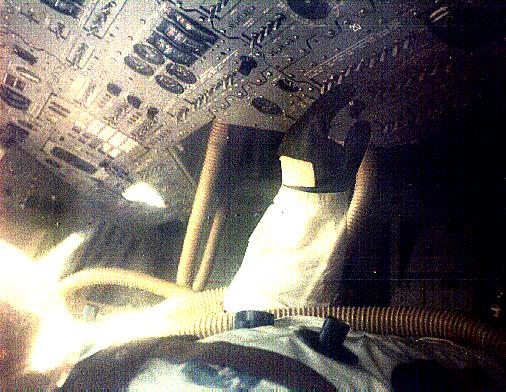
Apollo CSM Interior
Interior of the Apollo Command Service Module on display at Kennedy Space Centre, Florida.
Credit: © Mark Wade
AKA: Odyssye/Aquarius. Launched: 1970-04-11. Returned: 1970-04-17. Number crew: 3 . Duration: 5.95 days. Location: Kansas Cosmosphere and Space Center, Hutchinson, KS.
Apollo 13 (AS-508) was launched from Pad A, Launch Complex 39, KSC, at 2:13 p.m. EST April 11, with astronauts James A. Lovell, Jr., John L. Swigert, Jr., and Fred W. Haise, Jr., aboard. The spacecraft and S-IVB stage entered a parking orbit with a 185.5-kilometer apogee and a 181.5-kilometer perigee. At 3:48 p.m., onboard TV was begun for five and one-half minutes. At 4:54 p.m., an S-IVB burn placed the spacecraft on a translunar trajectory, after which the CSM separated from the S-IVB and LM Aquarius. (The crew had named lunar module 7 Aquarius and CSM 109 Odyssey.) The CSM then hard-docked with the LM. The S-IVB auxiliary propulsion system made an evasive maneuver after CSM/LM ejection from the S-IVB at 6:14 p.m. The docking and ejection maneuvers were televised during a 72-minute period in which interior and exterior views of the spacecraft were also shown.
At 8:13 p.m. EST a 217-second S-IVB auxiliary propulsion system burn aimed the S-IVB for a lunar target point so accurately that another burn was not required. The S-IVB/IU impacted the lunar surface at 8:10 p.m. EST on April 14 at a speed of 259 meters per second. Impact was 137.1 kilometers from the Apollo 12 seismometer. The seismic signal generated by the impact lasted 3 hours 20 minutes and was so strong that a ground command was necessary to reduce seismometer gain and keep the recording on the scale. The suprathermal ion detector experiment, also deployed by the Apollo 12 crew, recorded a jump in the number of ions from zero at the time of impact up to 2,500 shortly thereafter and then back to a zero count. Scientists theorized that ionization had been produced by 6,300 K to 10,300 K (6,000 degrees C to 10,000 degrees C) temperature generated by the impact or that particles had reached an altitude of 60 kilometers from the lunar surface and had been ionized by sunlight.
Meanwhile back in the CSM/LM, the crew had been performing the routine housekeeping duties associated with the period of the translunar coast. At 30:40 ground elapsed time a midcourse correction maneuver took the spacecraft off a free-return trajectory in order to control the arrival time at the moon. Ensuring proper lighting conditions at the landing site. The maneuver placed the spacecraft on the desired trajectory, on which the closest approach to the moon would be 114.9 kilometers.
At 10:08 p.m. EST April 13, the crew reported an undervoltage alarm on the CSM main bus B, rapid loss of pressure in SM oxygen tank No. 2, and dropping current in fuel cells 1 and 3 to a zero reading. The loss of oxygen and primary power in the service module required an immediate abort of the mission. The astronauts powered up the LM, powered down the CSM, and used the LM systems for power and life support. The first maneuver following the abort decision was made with the descent propulsion system to place the spacecraft back in a free-return trajectory around the moon. After the spacecraft swung around the moon, another maneuver reduced the coast time back to earth and moved the landing point from the Indian Ocean to the South Pacific.
About four hours before reentry on April 17, the service module was jettisoned and the crew took photographs and made visual observations of the damaged area. About one hour before splashdown the command module was powered up and the lunar module was jettisoned. Parachutes were deployed as planned, and the Odyssey landed in the mid-Pacific 6.4 kilometers from the recovery ship U.S.S. Iwo Jima at 1:07 p.m. EST April 17. The astronauts were picked up by helicopter and transported to the recovery ship less than an hour after splashdown.
Official NASA Account of the Mission from Where No Man Has Gone Before: A History of Apollo Lunar Exploration Missions, by W. David Compton, published as NASA SP-4214 in the NASA History Series, 1989.
Preparations for the launch proceeded without major problems through February and March 1970. Three days before launch, Jack Swigert took Ken Mattingly's place as command module pilot, after the prime crew had been exposed to German measles and Mattingly was found to have no immunity. Apollo 13 lifted off on schedule at 2:13 p.m. Eastern Standard Time on April 11, and for two days operations were routine; Capcom remarked at one point that flight controllers were bored to tears. A few hours later, however, an oxygen tank in the service module ruptured, depriving the spacecraft of most of its electrical power and oxygen, and the mission had to be aborted. Only a heroic effort of real-time improvisation by mission operations teams saved the crew.
Almost lost in the drama of the mission was the one piece of scientific information that Apollo 13 was able to provide. Shortly after command module pilot Jack Swigert had extracted the lunar module from atop the S-IVB stage, ground controllers fired the auxiliary propulsion system on the big rocket, putting it on a course to crash into the moon. Three days later the 30,700-pound (13,925 kilogram) hulk struck the lunar surface at 5,600 miles per hour (2.5 kilometers per second) some 74 miles (119 kilometers) west-northwest of the Apollo 12 landing site, releasing energy estimated as equivalent to the explosion of 7.7 tons (7,000 kilograms) of TNT. Half a minute later the passive seismometer left by Apollo 12 recorded the onset of vibrations that persisted for more than four hours. Another instrument, the lunar ionosphere detector, sensed a gas cloud that arrived a few seconds before the seismic signal and lasted for more than a minute. Seismologists were baffled by the moon's response to shock, but welcomed the new means of generating data.
In the year that it took to discover and correct the cause of the Apollo 13 failure, the scope of the remaining missions was altered. Apollo 14 would visit the site intended for exploration by Apollo 13, but it would go there as the last of the intermediate exploration missions.
More at: Apollo 13.
Family: Manned spaceflight. People: Haise, Lovell, Swigert. Country: USA. Spacecraft: Apollo CSM. Projects: Apollo. Launch Sites: Cape Canaveral. Agency: NASA Houston.
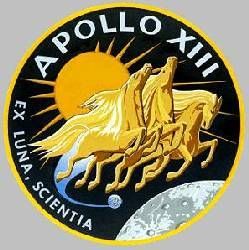 | Apollo 13 Credit: www.spacefacts.de |
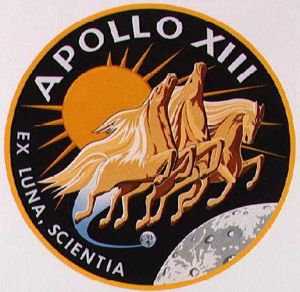 | Apollo 13 Apollo 13 Patch Credit: NASA |
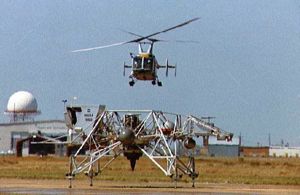 | Apollo 13 LLRV Training Credit: NASA |
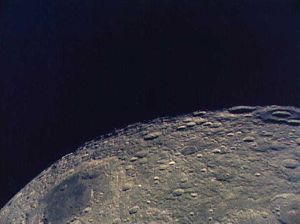 | Apollo 13 So close and yet so far... the moon as Apollo 13 swings by Credit: NASA |
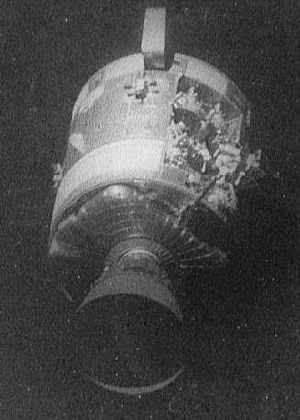 | Apollo 13 The destroyed service module Credit: NASA |
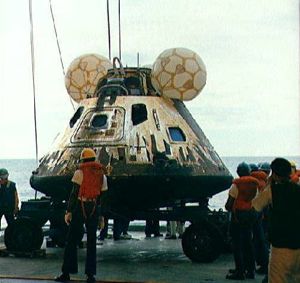 | Apollo 13 Apollo 13 safely on deck Credit: NASA |
1968 October 23 - .
- Two failures of Apollo LM propellant tanks fail during testing - . Nation: USA. Program: Apollo. Flight: Apollo 13. Spacecraft: Apollo LM, LM Weight. LeRoy E. Day, Apollo Test Director, NASA Hq., informed Apollo Program Director Samuel C. Phillips of two failures of LM propellant tanks during testing, a problem that might have significant program impact on LMs 6 and 7 and subsequent vehicles. . Additional Details: here....
1968 December 24 - .
- Plans for television cameras aboard remaining Apollo missions - .
Nation: USA.
Related Persons: Low, George.
Program: Apollo.
Flight: Apollo 13,
Apollo 9.
Spacecraft: Apollo LM,
CSM Block II,
LM Television.
ASPO Manager George M. Low apprised Program Director Samuel C. Phillips of MSC's plans for television cameras aboard remaining Apollo missions. With the exception of spacecraft 104 (scheduled for flight as Apollo 9), television cameras were to be flown in all CMs. Also, cameras would be included in all manned LMs (LM-3 through LM-14).
1969 February 3 - .
- 12-month plan for Apollo missions - .
Nation: USA.
Program: Apollo.
Flight: Apollo 10,
Apollo 11,
Apollo 12,
Apollo 13,
Apollo 9.
Spacecraft: Apollo LM,
CSM Recovery.
NASA Hq. released a 12-month forecast of manned space flight missions, reflecting an assessment of launch schedules for planning purposes. Five flights were scheduled for the remainder of 1969:
- Apollo 9 - February 28, SA-504, CSM 104, LM-3; manned orbital; up to 10 days' duration; Atlantic recovery.
- Apollo 10 - May 17, SA-505, CSM 106, LM-4; manned lunar mission, Pacific recovery.
- Apollo 11 - SA-506, CSM 107, LM-5; manned lunar mission; up to 11 days' duration; Pacific recovery.
- Apollo 12 - SA-507, CSM 108, LM-6; manned lunar mission; up to 11 days; Pacific recovery.
- Apollo 13 - SA-508, CSM 109, LM-7; manned lunar mission; up to 11 days' duration; Pacific recovery.
1969 April 18 - .
- Changes in launch readiness dates for Apollo 12 and Apollo 13 missions - . Nation: USA. Program: Apollo. Flight: Apollo 12, Apollo 13. ASPO announced changes in launch readiness dates for the Apollo 12 and Apollo 13 missions. Apollo 12 was moved up from September 18 to September 13, 1969; and Apollo 13 was moved up from December 1 to November 10..
1969 July 29 - .
- Tentative planning schedule for the Apollo program - .
Nation: USA.
Program: Apollo.
Flight: Apollo 12,
Apollo 13,
Apollo 14,
Apollo 15,
Apollo 16,
Apollo 17,
Apollo 18,
Apollo 19,
Apollo 20.
Spacecraft: Apollo Lunar Landing,
Surveyor.
NASA issued a tentative planning schedule for the Apollo program:
Flight Launch Plans Tentative Landing Area Apollo 12 November 1969 Oceanus Procellarum lunar lowlands Apollo 13 March 1970 Fra Mauro highlands Apollo 14 July 1970 Crater Censorinus highlands Apollo 15 November 1970 Littrow volcanic area Apollo 16 April 1971 Crater Tycho (Surveyor VII impact area) Apollo 17 September 1971 Marius Hills volcanic domes Apollo 18 February 1972 Schroter's Valley, riverlike channel-ways Apollo 19 July 1972 Hyginus Rille region-Linear Rille, crater area Apollo 20 December 1972 Crater Copernicus, large crater impact area
1969 November 4 - .
- Thermometer to read lunar surface temperature considered for Apollo 13 ALSEP - . Nation: USA. Program: Apollo. Flight: Apollo 13. Spacecraft Bus: Apollo LM. Spacecraft: Apollo ALSEP. Provision of a thermometer that could be attached to the ALSEP for the Apollo 13 mission, to take a reading of the lunar surface soil temperature, was being considered at MSC..
1970 January 14 - .
- Scientific debriefing of the Apollo 12 astronauts - . Nation: USA. Program: Apollo. Flight: Apollo 12, Apollo 13. The scientific debriefing of the Apollo 12 astronauts indicated there were areas of strong interest for which there was no data and that the data could have been provided by an Apollo lunar surface closeup stereo camera. . Additional Details: here....
1970 April 6-10 - .
- Swigert, Apollo 13 backup pilot, began intensive training to replace Mattingly - .
Nation: USA.
Program: Apollo.
Flight: Apollo 13.
Spacecraft: Apollo CSM.
Astronaut John L. Swigert, Jr., Apollo 13 backup command module pilot, began intensive training as a replacement for Thomas K. Mattingly II. The Apollo 13 prime crew had undergone a comprehensive medical examination after German measles had been contracted by Charles M. Duke, Jr., a member of the Apollo 13 backup crew. Mattingly had not shown immunity to the rubella virus and it was feared that he might become ill during the Apollo 13 flight.
1970 April 11 - . 19:13 GMT - . Launch Site: Cape Canaveral. Launch Complex: Cape Canaveral LC39A. Launch Platform: LUT3. Launch Vehicle: Saturn V.
- Apollo 13 - .
Call Sign: Odyssey. Crew: Haise,
Lovell,
Swigert.
Backup Crew: Duke,
Mattingly,
Young.
Support Crew: Brand,
Kerwin,
Lousma.
Payload: Apollo CSM 109 / Apollo LM 7 / ALSEP / S-IVB-508. Mass: 28,790 kg (63,470 lb). Nation: USA.
Agency: NASA Houston.
Program: Apollo.
Class: Moon.
Type: Manned lunar spacecraft. Flight: Apollo 13.
Spacecraft: Apollo CSM.
Duration: 5.95 days. Decay Date: 1970-04-17 . USAF Sat Cat: 4371 . COSPAR: 1970-029A. Apogee: 186 km (115 mi). Perigee: 184 km (114 mi). Inclination: 32.50 deg. Period: 88.31 min.
Apollo 13 (AS-508) was launched from Pad A, Launch Complex 39, KSC, at 2:13 p.m. EST April 11, with astronauts James A. Lovell, Jr., John L. Swigert, Jr., and Fred W. Haise, Jr., aboard. The spacecraft and S-IVB stage entered a parking orbit with a 185.5-kilometer apogee and a 181.5-kilometer perigee. At 3:48 p.m., onboard TV was begun for five and one-half minutes. At 4:54 p.m., an S-IVB burn placed the spacecraft on a translunar trajectory, after which the CSM separated from the S-IVB and LM Aquarius. (The crew had named lunar module 7 Aquarius and CSM 109 Odyssey.) The CSM then hard-docked with the LM. The S-IVB auxiliary propulsion system made an evasive maneuver after CSM/LM ejection from the S-IVB at 6:14 p.m. The docking and ejection maneuvers were televised during a 72-minute period in which interior and exterior views of the spacecraft were also shown.
At 8:13 p.m. EST a 217-second S-IVB auxiliary propulsion system burn aimed the S-IVB for a lunar target point so accurately that another burn was not required. The S-IVB/IU impacted the lunar surface at 8:10 p.m. EST on April 14 at a speed of 259 meters per second. Impact was 137.1 kilometers from the Apollo 12 seismometer. The seismic signal generated by the impact lasted 3 hours 20 minutes and was so strong that a ground command was necessary to reduce seismometer gain and keep the recording on the scale. The suprathermal ion detector experiment, also deployed by the Apollo 12 crew, recorded a jump in the number of ions from zero at the time of impact up to 2,500 shortly thereafter and then back to a zero count. Scientists theorized that ionization had been produced by 6,300 K to 10,300 K (6,000 degrees C to 10,000 degrees C) temperature generated by the impact or that particles had reached an altitude of 60 kilometers from the lunar surface and had been ionized by sunlight.
Meanwhile back in the CSM/LM, the crew had been performing the routine housekeeping duties associated with the period of the translunar coast. At 30:40 ground elapsed time a midcourse correction maneuver took the spacecraft off a free-return trajectory in order to control the arrival time at the moon. Ensuring proper lighting conditions at the landing site. The maneuver placed the spacecraft on the desired trajectory, on which the closest approach to the moon would be 114.9 kilometers.
At 10:08 p.m. EST April 13, the crew reported an undervoltage alarm on the CSM main bus B, rapid loss of pressure in SM oxygen tank No. 2, and dropping current in fuel cells 1 and 3 to a zero reading. The loss of oxygen and primary power in the service module required an immediate abort of the mission. The astronauts powered up the LM, powered down the CSM, and used the LM systems for power and life support. The first maneuver following the abort decision was made with the descent propulsion system to place the spacecraft back in a free-return trajectory around the moon. After the spacecraft swung around the moon, another maneuver reduced the coast time back to earth and moved the landing point from the Indian Ocean to the South Pacific.
- Apollo 13 LM - . Call Sign: Aquarius. Payload: Apollo LM 7. Mass: 15,192 kg (33,492 lb). Nation: USA. Agency: NASA Houston. Program: Apollo. Class: Moon. Type: Manned lunar spacecraft. Flight: Apollo 13. Spacecraft: Apollo LM. Duration: 5.95 days. Decay Date: 1970-04-17 . USAF Sat Cat: 4371 . COSPAR: 1970-029x. Apogee: 186 km (115 mi). Perigee: 184 km (114 mi). Inclination: 32.50 deg. Period: 88.31 min.
1970 April 13-June 15 - .
- Apollo 13 - "Hey - we've got a problem here" - .
Nation: USA.
Program: Apollo.
Flight: Apollo 13.
Spacecraft: Apollo CSM,
CSM Electrical.
"Hey, we've got a problem here." The message from the Apollo 13 spacecraft to Houston ground controllers at 10:08 p.m. EDT on April 13, initiated an investigation to determine the cause of an oxygen tank failure that aborted the Apollo 13 mission. Additional Details: here....
1970 April 15 - .
- Apollo 13 swings behind the moon - .
Nation: USA.
Flight: Apollo 13.
At 00:21:35 GMT Apollo 13 passed behind the moon, out of radio contact with earth. Flying high above the lunar surface, the crew reached a distance of 401,056 km from the center of the earth, an all-time altitude record. At 02:40:39 GMT the cold, exhausted, and ailing crew conducted a completely manual 4 minute 23 second burn of the LM descent engine to reduce the coast time back to earth and moved the landing point from the Indian Ocean to the South Pacific. Additional Details: here....
1970 April 17 - .
- Apollo 13 Review Board established - . Nation: USA. Program: Apollo. Flight: Apollo 13. NASA Hq. established an Apollo 13 Review Board to investigate the Apollo 13 accident..
1970 April 17 - .
- Landing of Apollo 13 - .
Return Crew: Haise,
Lovell,
Swigert.
Nation: USA.
Related Persons: Haise,
Lovell,
Swigert.
Program: Apollo.
Flight: Apollo 13.
About four hours before reentry on April 17, the service module was jettisoned and the crew took photographs and made visual observations of the damaged area. About one hour before splashdown the command module was powered up and the lunar module was jettisoned. Parachutes were deployed as planned, and the Odyssey landed in the mid-Pacific 6.4 kilometers from the recovery ship U.S.S. Iwo Jima at 1:07 p.m. EST (18:07 GMT). The astronauts were picked up by helicopter and transported to the recovery ship less than an hour after splashdown.
1970 April 17 - . 18:07 GMT - .
- Safe splashdown of Apollo 13 - .
Nation: USA.
Flight: Apollo 13.
About four hours before reentry, the service module was jettisoned and the crew took photographs and made visual observations of the damaged area. About one hour before splashdown the command module was powered up and the lunar module was jettisoned. Parachutes were deployed as planned, and the Odyssey landed in the mid-Pacific 6.4 kilometers from the recovery ship U.S.S. Iwo Jima at 18:07 GMT April 17. The astronauts were picked up by helicopter and transported to the recovery ship less than an hour after splashdown.
1970 April 18 - .
- Kamanin considers the Apollo 13 mission. - .
Nation: Russia.
Program: Lunar L3,
Apollo.
Flight: Apollo 13.
He believes it was a 'true test' of American technical capability in space. The saving of the American astronauts demonstrated the robust redundancy in the American Saturn V - Apollo design, as compared with the Soviet N1-L3. The latter, Kamanin remarks, is a bad launch vehicle, boosting a bad spacecraft. Kamanin sees the Soviet science fiction film Solaris - and finds it too fantastic for his taste.
1970 April 19 - .
- Apollo 13 Review Board panels established - . Nation: USA. Program: Apollo. Flight: Apollo 13. Spacecraft: Apollo CSM, CSM Electrical, CSM Fuel Cell, CSM RCS. To support the Apollo 13 Review Board, an MSC Apollo 13 Investigation Team, headed by Scott H. Simpkinson, was established with the several panels.. Additional Details: here....
1970 June 13 - .
- Apollo 13 Review Board publishes result of investigation. - .
Nation: USA.
Flight: Apollo 13.
The explosion was found to have been caused by a bare-wire heating element within the fuel cell liquid oxygen tank. The element itself had burnt off its insulation through a combination of unimplemented specification changes early in the programme coupled with unauthorised procedures during ground testing. Additional Details: here....
1970 June 26 - .
- Actions initiated as a result of Apollo 13 Review Board - . Nation: USA. Program: Apollo. Flight: Apollo 13. NASA Hq. and Center actions were initiated on recommendations of the Apollo 13 Review Board. . Additional Details: here....
1970 July 14 - .
- Apollo 13 investigation personnel redirected to the Apollo-experience-reporting project - . Nation: USA. Program: Apollo. Flight: Apollo 13. Efforts of MSC personnel that had been redirected to support the Apollo 13 investigation would again be concentrated on the Apollo-experience-reporting project in an effort to attain a publication date of November 1, 1970..
1970 July 16 - .
- Reassessment of all Apollo spacecraft subsystems - . Nation: USA. Program: Apollo. Flight: Apollo 13. MSC moved to reassess all Apollo spacecraft subsystems and the engineering organizations responsible for them at MSC and its prime contractors, in response to Apollo 13 Review Board recommendation 9..
1970 November 24 - .
- MSC Director Robert R Gilruth reported MSC actions on the Apollo 13 Review Board recommendations - . Nation: USA. Program: Apollo. Flight: Apollo 13, Apollo 14. Spacecraft: Apollo CSM, CSM ECS, CSM Electrical, CSM Fuel Cell. MSC Director Robert R. Gilruth reported MSC actions on the Apollo 13 Review Board recommendations.. Additional Details: here....
1971 March 1 - . Launch Vehicle: N1.
- N1-L3 loses remaining priority - .
Nation: Russia.
Related Persons: Mishin.
Program: Lunar L3.
Flight: Apollo 13,
Apollo 14.
Spacecraft: LK,
Soyuz 7K-LOK.
The Soviet leadership regained some interest in the N1-L3, after the near-tragedy of Apollo 13. It was felt that the Americans might cancel the remainder of the Apollo programme, leaving the road to the moon clear for the Soviet Union. However the successful flight of Apollo 14 redeemed the project, and the Central Committee lost all interest in the N1-L3. Additional Details: here....
1974 January - .
- Television version of Apollo 13 mission - .
Nation: USA.
Program: Apollo.
Flight: Apollo 13.
Universal Studios filmed a program for the ABC TV Network entitled, "Houston, We've Got a Problem." Although fictitious, the show revolved around mission control and the flight controllers during the Apollo 13 mission. The production was televised March 2, 1974.
1995 June 30 - .
- Apollo 13 motion picture is released. - .
Nation: USA.
Flight: Apollo 13.
Ron Howard's cinematic version of the Apollo 13 mission is released. Tom Hanks, Bill Paxton, and Kevin Bacon portray the crew with Gary Sinise as the grounded Mattingly and Ed Harris as flight controller Gene Kranz. The film grosses $ 334.1 million worldwide and reawakens popular awareness and interest in the space race of the 1960's.
1998 April 5 - .
- From the Earth to the Moon is released. - .
Nation: USA.
Flight: Apollo 11,
Apollo 12,
Apollo 13,
Apollo 14,
Apollo 15,
Apollo 17,
Apollo 7,
Apollo 8,
Apollo 9.
Based on the success of the film Apollo 13, Tom Hanks was able to raise $ 68 million to film a television mini-series covering the entire Apollo program. The Apollo 13 episode marked the third fictionalised telling of the tale, this time concentrating on the media handling of the flight and the changing nature of television news. Additional Details: here....
Back to top of page
Home - Search - Browse - Alphabetic Index: 0- 1- 2- 3- 4- 5- 6- 7- 8- 9
A- B- C- D- E- F- G- H- I- J- K- L- M- N- O- P- Q- R- S- T- U- V- W- X- Y- Z
© 1997-2019 Mark Wade - Contact
© / Conditions for Use